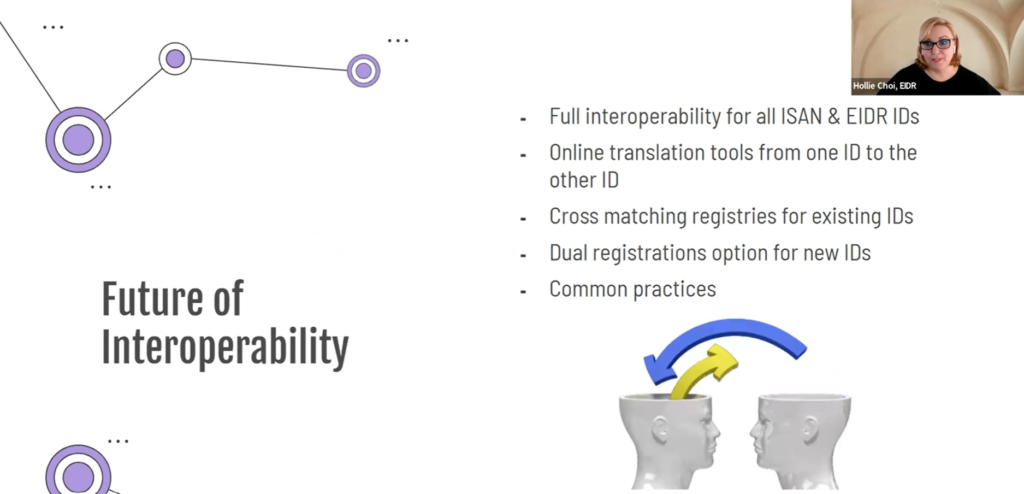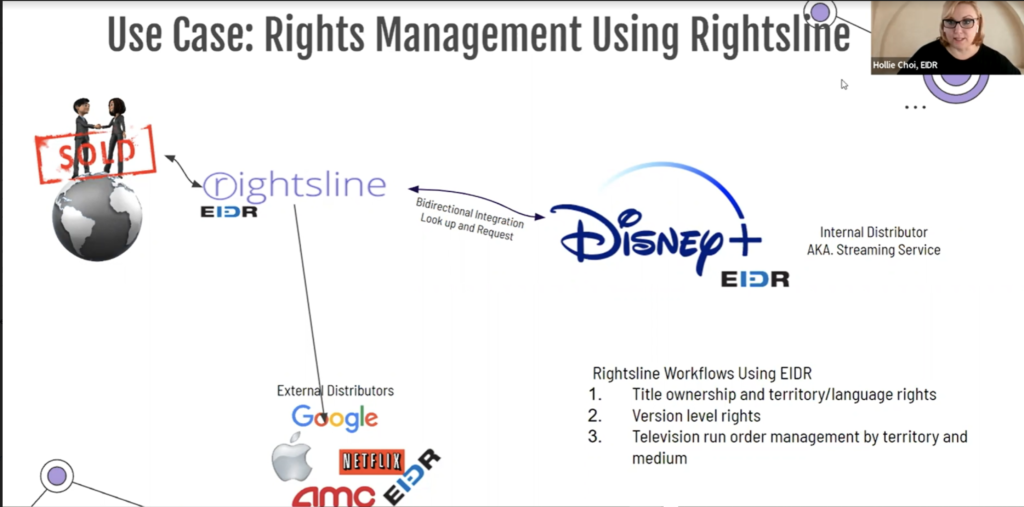M+E Connections

EIDR, ISAN Provide Updates on Their ID Standard Registries
Story Highlights
Directors of the Entertainment ID Registry (EIDR) and International Standard Audiovisual Number (ISAN) International Agency provided updates on their respective identifier standard registries during the recent webinar “Rights Data and Audiovisual Identifiers.”
EIDR’s industry standard registry was initiated by Hollywood studios, research and development (R&D) organisations and industry vendors, and its initial purpose was to identify audio visual works and their unique versions, “who their original producers were and then streamline digital distribution through automation,” according to Hollie Choi, EIDR executive director.
The “mission” was to establish a public registry to identify audio visual works and unique versions produced by specific content creators, allowing for more efficient distribution and sales of media and entertainment products across the global digital supply chain, she explained.
The member organisation’s primary content includes TV shows and movies, along with edits and “manifestations” of them, she said. EIDR also handles some shorts and recently added podcasts, she noted.
“At this point, we have issued about 2.5 million EIDR identifiers” and the organisation has more than 73 member companies, she said, pointing out there are also about 5 million alternate identifiers, including those of ISAN, “for a lot of the content.”
EIDR also provides application programming interfaces (APIs) and 99.5% of the API calls are read or resolve, she said. Therefore, “it’s only a very small fraction of the API calls that are being used to register the new content, so it’s a lot of re-use that is happening,” she added.
 The ISAN International Agency’s International Organisation for Standardisation (ISO) standard, meanwhile, was initiated by rights holders organisations and its initial purpose was to create universal, unique audio visual identifier to “streamline digital rights management” (DRM), according to Régis Flad, its managing director.
The ISAN International Agency’s International Organisation for Standardisation (ISO) standard, meanwhile, was initiated by rights holders organisations and its initial purpose was to create universal, unique audio visual identifier to “streamline digital rights management” (DRM), according to Régis Flad, its managing director.
Once an ISAN is assigned, “anyone who needs to identify a specific version of a work can then do it,” he said.
Project ISAN IDs are delivered for works that are still in development and only producers have access to them, he pointed out. Once the work is completed and made available in the market, ISAN IDs are made public and become usable by all, he added.
ISAN IDs are stored in a central registry, together with the works’ metadata, and the main uses of them today are rights management, film projects management and video-on-demand (VOD) content identification, according to Flad.
“The ISAN system is backed up by a network of 15 registration agencies that are working on a national or regional basis and … work directly with producers,” he said, adding the system has more than 20,000 users in 81 countries now.
Underscoring why identifiers are so important, he pointed to a 2012 Israeli movie that was originally called Rock Ba-Casba but known as Rock the Casbah internationally, each version containing different metadata. Adding potentially more layers of complication were the different 2013 French-Moroccan film that was also called Rock the Casbah and the different 2015 U.S. film called Rock the Kasbah, he noted.
Use Cases
“To put all of this in perspective,” Choi pointed to one of the specific industry use cases for EIDR, noting that Rightsline (USA) is a rights management system that is “underpinned” with the EIDR model. Rightsline allows content creators to license the appropriate version of each property to each client based on territory, language, release window and other factors, she explained.
Disney Plus, for example, may be looking for content to add to its streaming service in certain territories and it has a “bi-directional integration” pact with Rightsline, she noted. Disney will put in a request through Rightsline for a certain piece of content it wants to include on its streaming service and Rightsline will let the rights management know that request has been made and a deal is then made, she explained. So Rightsline uses EIDR for title ownership and territory/language rights, she noted. Additionally, Rightsline uses EIDR for version level rights and TV run order management by medium and territory, she said.
 Flad then pointed to two specific industry use cases for ISAN, noting it’s used by French anti-piracy group l’Association de Lutte Contre la Piraterie Audiovisuelle (ALPA) for music rights management in audio visual content and as a “one stop shop for fingerprints,” providing centralised fingerprint management and the ability to take down infringed content and manage claims as part of agreements with Facebook and Google.
Flad then pointed to two specific industry use cases for ISAN, noting it’s used by French anti-piracy group l’Association de Lutte Contre la Piraterie Audiovisuelle (ALPA) for music rights management in audio visual content and as a “one stop shop for fingerprints,” providing centralised fingerprint management and the ability to take down infringed content and manage claims as part of agreements with Facebook and Google.
There is, meanwhile, a “shared community” of users that need to register both EIDR and ISAN IDs, Choi went on to say, adding that, so far, there are over 200,000 public EIDR-ISAN cross-references. “Both registries will resolve” those cross-references, she said.
And “there is a basic dual registration process that’s available today,” which requires a bit of a manual effort today, she added.
Future Goals
Looking ahead, Choi said, “we want to make the registration of both an EIDR and an ISAN simultaneous,” so the registration process and resolutions are more cohesive and automated.
The organisations also want to do joint venture APIs so that companies “can plug in [their] individual business systems into both registries” so they can plug in all the information just once,” she noted.
Also planned are an additional cross-reference mapping programme and “we’ll be working on some interim solutions – things that make it a little bit easier for everybody in the meantime,” she added.
Looking further ahead, she said, “we want to be able to have interoperability between the two identifier registries,” using similar tools, similar metadata and cross-matching. The goal is also to have a dual registrations option for new IDs and “some common practices,” she added.
Flad ended the webinar by stressing how the effective use of standard IDs benefits rights holders and conceding there are some areas where improvement can be made.
Standard IDs help media and entertainment companies process the huge volumes of data required today, while cutting down the cost of basic rights processing, enabling chief media officers to focus their time on high value tasks such as conflict resolution, reducing errors, increasing granularity and accuracy, and adding value to content recognition tools, he pointed out.
There is, meanwhile, room for improvement by encouraging both the development and use of messaging standards for the audiovisual sector and the use of interoperable standard IDs including EIDR and ISAN, he concluded.









